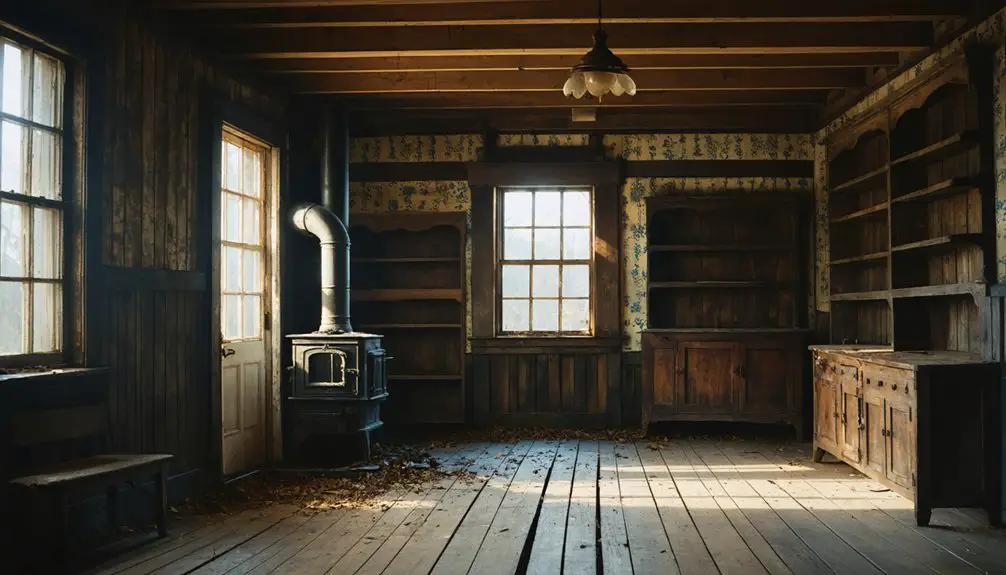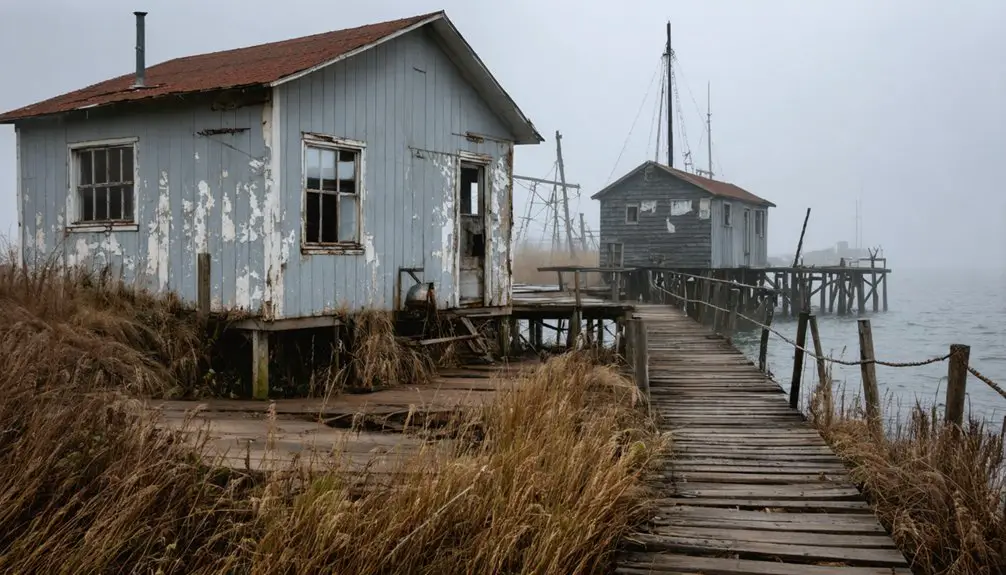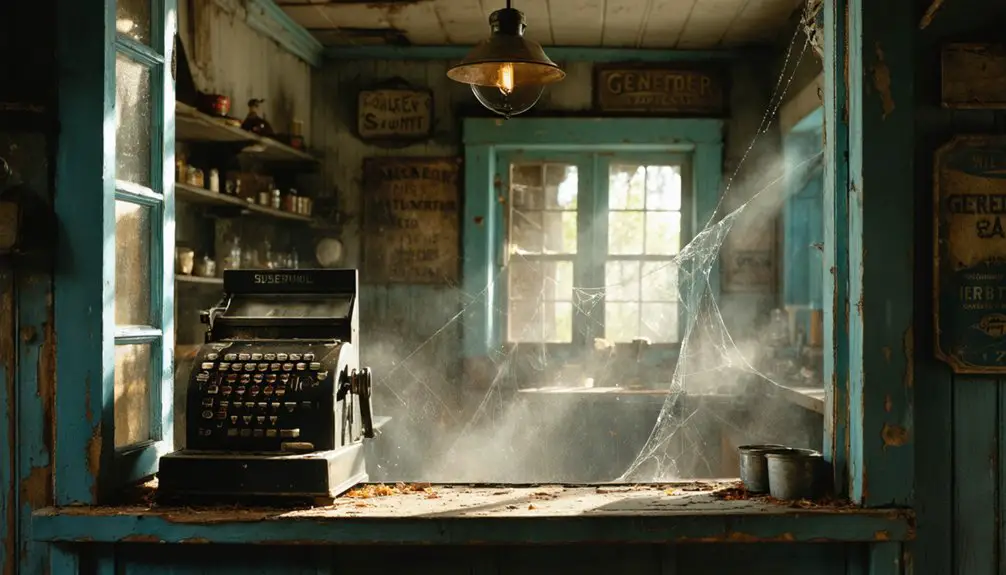You’ll find Grand Chute’s vanished village center along Wisconsin’s Fox River, where French fur traders first established posts near the powerful rapids called “La Grand Chute” in the 1760s. Though it became Outagamie County’s seat in 1851, the settlement gradually lost influence to neighboring Appleton. Today, few original structures remain in this ghost neighborhood, but its legacy lives on through preserved historic buildings and the thriving Fox Cities metropolitan area they helped create.
Key Takeaways
- Grand Chute transformed from a bustling trading hub into a ghost neighborhood as neighboring Appleton gained prominence and commercial importance.
- Originally established as the village of Martin in 1849, Grand Chute failed multiple incorporation attempts in the 1980s.
- Few original structures from the historic settlement remain today, marking its decline from a once-thriving community.
- The area experienced significant demographic shifts, with population and economic activity moving toward nearby Appleton.
- Despite its ghost town status, Grand Chute’s historic buildings are preserved through listings on the National Register of Historic Places.
The Birth of a River Settlement
While the Fox River had long served as a vital artery for Native American life and trade, the area that would become Grand Chute first emerged as a significant settlement point during the early French exploration period.
The Fox River served as the beating heart of Native American civilization before French explorers discovered its strategic settlement potential.
You’ll find the footprints of the Winnebago and Menominee tribes here first, establishing seasonal villages and sharing the bountiful hunting grounds along the waterway.
When Jean Nicolet arrived in 1634, followed by Marquette and Joliet in 1673, they discovered an already-thriving network of river navigation routes.
The rushing waters cascaded over a rocky ledge, creating a dramatic natural spectacle visible from a mile away.
By 1760, French-Canadian Métis traders, including the influential Grignon family, had set up posts near the rushing rapids of “La Grand Chute.”
This strategic location, where water met commerce, would shape the destiny of this riverside community for generations to come. The French maintained their influence in the region until the French and Indian War ended in 1763.
Origins of the Grand Chute Name
When French explorers and fur traders first navigated the tumultuous waters of the Fox River, they encountered a significant rapids that would give Grand Chute its enduring name.
You’ll find French influence deeply embedded in the town’s identity, as “Grand Chute” translates to “great fall” or “large rapids,” reflecting the prominent water feature that shaped local geography. Today, at an elevation of 790 feet, the town’s terrain still bears witness to these historic river features.
The French word “chute,” meaning waterfall or rapids, became a common descriptor in the region’s river-based nomenclature. Native American tribes, including the Winnebago (Ho-Chunk) and Menominee, had their own names for these essential river characteristics, but the French terms prevailed during colonial settlement.
You can see this pattern in nearby places like Little Chute (Le Petite Chute), showcasing how river features directly influenced community naming throughout the Fox River Valley.
Early Trading and Development
You’ll find Grand Chute’s earliest commercial roots at the Fox River’s Grand Kakalin rapids, where French fur traders established key posts before 1760, creating essential trade connections between the Atlantic Ocean and Mississippi River.
Charles de Langlade and Pierre Grignon ran thriving trading operations here, conducting business with large populations of Menominee and Winnebago peoples who maintained seasonal villages along the waterway. The challenging navigation through the area’s abrupt banks and roaring waters made it a significant point for trade along the Fox River.
The settlement grew considerably, reaching over 1,500 inhabitants by the late 18th century as native peoples and French-Indian traders formed a bustling river commerce hub at what would later become Kaukauna. In 1793, this location became historically significant as the site of the first land sale in Wisconsin.
Fox River Commerce Hub
The Fox River’s strategic location served as the lifeblood of Grand Chute’s early commercial development in the 19th century, establishing itself as an essential trading hub between Native American tribes and European settlers.
You’d have found river transportation vital to the area’s growth, with canoes and riverboats moving furs, agricultural goods, and basic supplies along the waterway. The Appleton Locks system enhanced navigation, while traders built warehouses and storage facilities along the riverbank. The area’s commercial success continued into modern times with the Fox River Mall becoming a billion-dollar contributor to the local economy. The mall’s vast 1.21 million square feet of retail space transformed the region’s shopping landscape.
Trade relationships flourished as Native Americans exchanged furs and crafts for European tools, fostering cultural exchanges that shaped the region’s development.
The trading post’s success attracted merchants and settlers, transforming Grand Chute from a simple fur trading outpost into a diversified commercial center that connected rural hinterlands with emerging settlements throughout the Fox River corridor.
Pioneer Trading Settlement Growth
French explorers and indigenous tribes laid the foundation for Grand Chute’s early settlement, beginning with Jean Nicolet’s arrival in 1634. The pioneer lifestyle emerged from trading dynamics between French fur traders and Native Americans, particularly the Winnebago and Menominee tribes who established seasonal villages along the Fox River.
- French-Canadian Métis managed trading posts that became crucial commerce hubs.
- The Grignon family operated strategic posts near the rapids by 1760.
- Pioneer settlers like Roland Garner began establishing 80-acre farms in the 1830s.
- Early homesteads were built near former fur trading locations.
- Religious institutions, including St. John’s parish, strengthened community bonds.
The settlement’s growth reflected a careful balance between maintaining profitable trade relationships and developing agricultural independence, with the Fox River serving as the region’s economic lifeline.
The Rise and Fall of a Village
Originally established as the village of Martin in 1849, Grand Chute emerged as a promising settlement along the Fox River near Lawrence Institute, thanks to the entrepreneurial vision of Morgan L. Martin, Theodore Conkey, and Abram B. Bowen.
The village dynamics quickly evolved as Grand Chute positioned itself as an essential trading hub, securing its role as the Outagamie County seat in 1851. A prime trading center developed along the Fox River, attracting merchants and settlers alike.
However, demographic shifts began favoring neighboring Appleton, which steadily overshadowed Grand Chute’s commercial importance.
As Appleton’s population and commerce grew, it gradually eclipsed its smaller neighbor Grand Chute in regional significance.
You’ll find that despite its early promise, Grand Chute’s independent status gradually eroded as Appleton’s expansion consumed the once-thriving village.
Today, few original structures remain to tell the tale of this pioneer settlement, which has transformed from a bustling river town into a ghost neighborhood within Appleton’s city limits.
Historical Buildings and Preservation

While many historic structures in Grand Chute have succumbed to urban development, several significant buildings still stand as monuments to the area’s rich architectural heritage.
Similar to the Hearthstone Historic House Museum in nearby Appleton, these preserved buildings provide vital links to the region’s past.
You’ll find that historic preservation efforts in the community are guided by both state and federal frameworks, ensuring these treasures remain protected for future generations.
- Sen. Joe McCarthy House showcases elegant Queen Anne styling with its original balloon frame
- Schwalbach Brothers Farm represents the area’s agricultural roots with its distinctive gabled ell design
- St. Mary’s Cemetery, established 1865, continues to demand careful infrastructure planning
- Wisconsin’s extensive preservation databases help track architectural diversity
- Local ordinances work alongside state laws to protect historic sites during development
The town’s preservation approach balances progress with protection, as demonstrated during the 2020 Prospect Avenue project, where careful coordination preserved cemetery features while updating essential infrastructure.
The State Historical Society maintains comprehensive public records of historic properties in the region, providing valuable documentation of structures that may no longer exist.
Life Along the Fox River
Prior to becoming the thriving waterway you know today, the Fox River presented treacherous rapids and falls that challenged early settlers, with Grand Chute’s notorious rapids near S. Jackman Street posing significant hazards to river navigation.
You’d have witnessed remarkable changes by the 1850s, as immigrant communities transformed the river’s landscape.
Dutch settlers, drawn by the Fox and Wisconsin Improvement Company‘s offer of free transportation, arrived to work on an ambitious system of locks and canals. Their efforts paid off when the steamship Aquila successfully navigated from Green Bay to the Mississippi River in 1856, followed by vessels like the Appleton Belle and Ajax.
These developments didn’t just improve transportation – they created tight-knit communities along the river, complete with schools, churches, and shared cultural bonds.
From Town to Ghost Neighborhood
Despite its promising beginnings as the village of Martin in 1849, Grand Chute‘s journey from independent town to ghost neighborhood reflects the complex evolution of Wisconsin’s early settlements.
As Appleton expanded, Grand Chute’s community identity gradually faded through urban integration, leading to its eventual absorption into the larger city.
- Failed incorporation attempts in the 1980s highlighted the area’s non-compact character
- Population of 10,874 residents witnessed their town’s governance diminish
- Original buildings earned spots on the National Register of Historic Places
- Shift from rural township to urban neighborhood erased independent status
- Few physical remnants remain to tell the story of the original settlement
The once-independent village now exists as a ghost neighborhood, its legacy preserved mainly through historical records and the scattered historic structures that survived Appleton’s expansion.
Legacy in Modern Appleton
Although Grand Chute’s independent identity faded into Appleton’s expanding boundaries, its legacy profoundly shapes the modern Fox Cities metropolitan area.
You’ll find Grand Chute’s influence in Appleton’s cultural integration through historic “firsts” – from the nation’s first hydroelectric home to Wisconsin’s earliest telephone system. The economic shift from water-powered mills to today’s diverse industries traces back to Grand Chute’s strategic location along the Fox River.
The area’s growth continues, with Grand Chute’s population exceeding 23,000 and Appleton reaching 74,000. Together, they anchor a quarter-million metro region essential to northeastern Wisconsin.
The collaborative relationship between these communities reflects in shared infrastructure, educational institutions like Lawrence University, and ongoing municipal evolution through annexations and boundary adjustments since the 1950s.
Frequently Asked Questions
What Happened to the Original Residents When Grand Chute Declined?
When push came to shove, you’d have seen original inhabitants packing up for nearby towns like Appleton, while others joined population migration to emerging villages like Hortonia, Dale, Greenville, and Ellington.
Are There Any Documented Paranormal Activities in Grand Chute’s Historic Buildings?
You won’t find officially documented ghost sightings or haunted locations in these historic buildings, as there aren’t any verified paranormal investigations or recorded supernatural events in local historical records.
What Native American Tribes Inhabited the Area Before Grand Chute’s Establishment?
You’ll find the Winnebago (Ho-Chunk) and Menominee were primary inhabitants, with rich Menominee history along the Fox River. Later, the Oneida tribe arrived through relocation in the 1820s.
How Did the Railroad System Impact Grand Chute’s Development?
You’ll find that railroad expansion through the Fox River Valley drove significant economic growth, connecting communities to essential trade networks and boosting settlement, manufacturing, and agricultural development in the region.
Were There Any Major Natural Disasters That Affected Grand Chute?
Like nature’s fury released, you’ll find your area’s most devastating historical impacts came from tornadoes, floods, and a deadly 1995 heat wave that claimed 57 lives in Outagamie County.
References
- https://en.wikipedia.org/wiki/Grand_Chute
- https://en.wikipedia.org/wiki/Grand_Chute_(ghost_town)
- https://raregoldnuggets.com/?p=3963
- https://kids.kiddle.co/Grand_Chute_(ghost_town)
- https://www.townofgraftonwi.gov/town-history/
- https://en.wikipedia.org/wiki/Little_Chute
- https://www.littlechutewi.org/DocumentView.asp?DID=200
- http://oldthirdward.org/settlers.html
- http://oldthirdward.org/otwhistory.html
- https://lavendermagazine.com/featured-home-page/the-fox-cities-wisconsin-a-river-runs-through-it/



